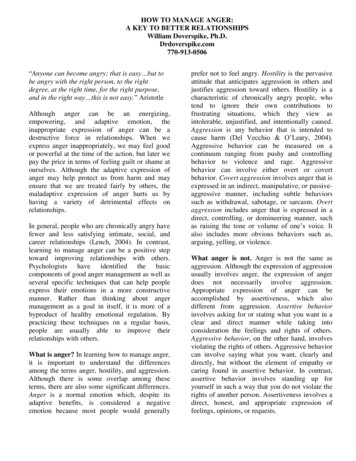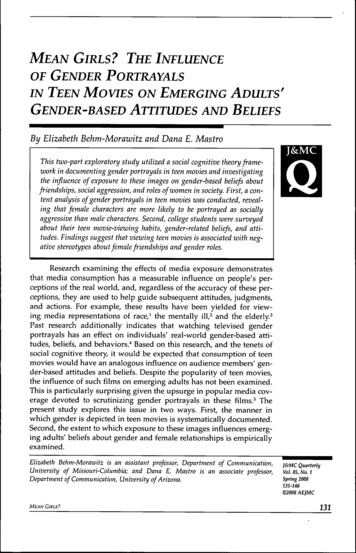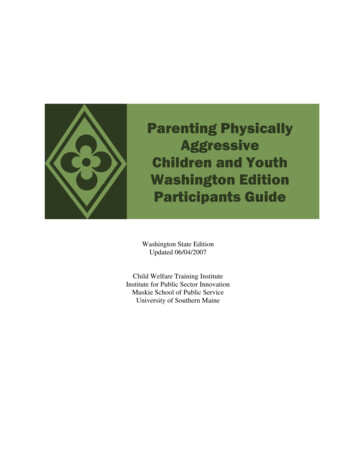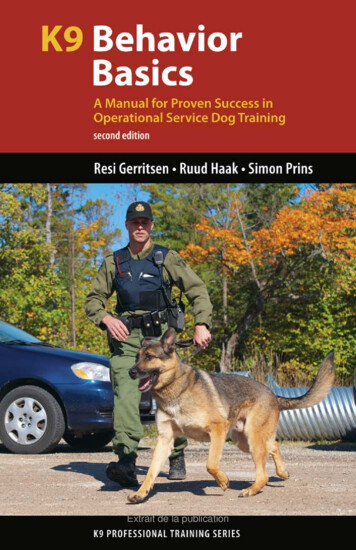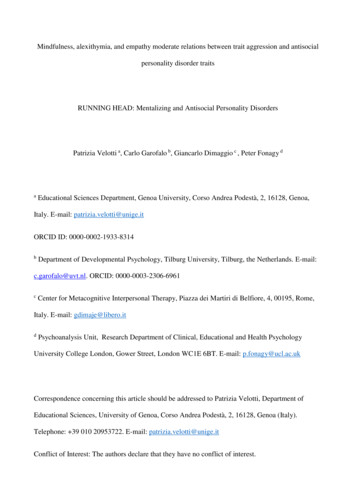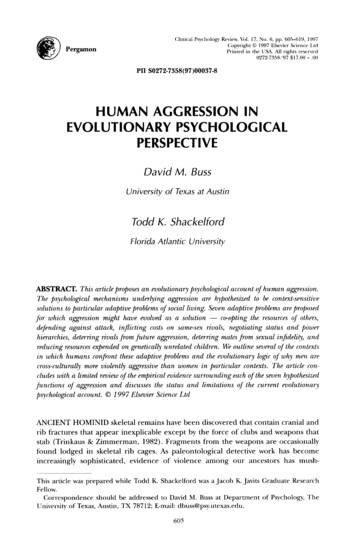
Transcription
On Aggression‘No one concerned with animals, whether in the home, on thefarm, or in the wild, whether with fish, lizards, birds, or cats; andabove all no one concerned with the overriding dilemmas posedby population growth and by war can afford to neglect KonradLorenz’s book.’W.H. Thorpe‘His writing displays an unusually happy blend of erudition,wisdom and humour. He uses anecdote, illustration and aside,without one whit impairing his status as a distinguished man ofscience . . . There can be few biologists . . . who have handled, livedwith, and made original observations upon so many differentspecies of living creatures.’Anthony Storr (1966)‘On Aggression is essential reading for all psychologists, psychoanalysts, sociologists and biologists – indeed for everyone whotakes evolutionary theory seriously and is concerned with thedanger to civilization implicit in our ignorance of the nature ofaggression.’Charles Rycroft, New Statesman‘Few men are better qualified than Professor Lorenz to show ushow we could profit from animal behaviour studies . . . It would bedeplorable if this product of unrivalled knowledge and rare intuition would be accepted merely as just another interesting storyabout animal behaviour.’N. Tinbergen
KonradLorenzOn AggressionTranslated by Marjorie Kerr WilsonWith a foreword by Julian HuxleyLondon and New York
Das Sogenannte Böse, Zur Naturgeschichte derAggression first published 1963by Verlag Dr Borotha-Schoeler, Vienna, AustriaFirst published in the United Kingdom 1966by Methuen & Co. LtdFirst published in Routledge Classics 2002by Routledge11 New Fetter Lane, London EC4P 4EERoutledge is an imprint of the Taylor & Francis GroupThis edition published in the Taylor and Francis e-Library, 2005.“To purchase your own copy of this or any of Taylor & Francis or Routledge’scollection of thousands of eBooks please go to www.eBookstore.tandf.co.uk.” 1983 Deutscher Taschenbuch Verlag GmbH & Co. KG,Munich, GermanyThis edition 1966, 2002 RoutledgeAll rights reserved. No part of this book may be reprintedor reproduced or utilised in any form or by any electronic,mechanical, or other means, now known or hereafterinvented, including photocopying and recording, or inany information storage or retrieval system, withoutpermission in writing from the publishers.British Library Cataloguing in Publication DataA catalogue record for this book is available from the British LibraryLibrary of Congress Cataloging in Publication DataA catalog record for this book has been applied forISBN 0-203-99426-4 Master e-book ISBNISBN 0–415–28319–1 (hbk)ISBN 0–415–28320–5 (pbk)
C ONTENTSForeword by Sir Julian Huxley, f.r.s.Introduction1234567891011121314Prologue in the SeaCoral Fish in the LaboratoryWhat Aggression is Good ForThe Spontaneity of AggressionHabit, Ritual and MagicThe Great Parliament of InstinctsBehavioural Analogies to MoralityAnonymity of the FlockSocial Organization without LoveRatsThe BondOn the Virtue of Scientific HumilityEcce Homo!Avowal of Optimismviiix1920465482105134145152160213228266
vicontentsRecommended BooksBibliographyIndex291293299
F OREWORDby Sir Julian Huxley, f.r.s.Konrad Lorenz is the father of modern ethology, that rapidlygrowing branch of science which is destined to provide a strongfoundation for the science of human behaviour and psychology.He has initiated a new interpretation of vertebrate behaviour.This is composed of ‘behaviour-units’, just as anatomy is composed of structural units. These have a genetic basis, and in thecourse of evolutionary time have been modified by Darwiniannatural selection to act as specific signals for communicatingemotional states. In the frequent cases where aggression and fearare involved they are modified so as to reduce the risk of intraspecific damage, and to permit close proximity between potential mates without arousing the aggression and fear which aclose approach tends to elicit. Thus in the course of evolution allthese behaviour-patterns tend to get ritualized or formalized,with exaggeration of prominent features, like grebes’ ruffs andear-tufts, and with enhanced variety and signalling efficiency.In addition, when conflicting drives come into conflict, thepent-up nervous energy may spill over into quite irrelevant
viii forewordbehaviour, like the grebes’ false wing-preening, or our ownhead-scratching when puzzled or undecided. And these displacement activities, as they are called, are often ritualized andmodified, so as to become incorporated in the display, like thedisplacement wing-preening of ducks, culminating in the Mandarin Duck, where the preened region of the wing is picked outby exaggerated size and colour.In many vertebrates, like grebes and Lorenz’s geese, theenergy of the aggressive drive may be recanalized to create anemotional bond between mates or comrades: this is mostmarked in higher groups.In this book, Lorenz deals with the evolution of aggression invertebrates. He points out that aggressivity is totally differentfrom predation: that it is a biological necessity for defence ofterritory and for a cornered animal, and that it becomes mixedup with other innate drives, thus leading up towards reductionof intraspecific damage. This, be it noted, is most evident infiercer social predators like wolves, where escape from the packis virtually impossible and where co-operation without fightingis necessary for survival; whereas in the non-social but proverbially peaceful dove prevention of escape leads to violent and oftenfatal attacks on the weaker mate.In a final chapter he advances some suggestion as to how inthe human species, where evolution is primarily cultural, andnot guided by Darwinian selection in the strict sense, the aggressive drive may be canalized into less dangerous channels. Manhas innumerable ways of adaptively ritualizing his behaviour,many of them analogous, if not homologous, to those found inanimals. In any event, On Aggression is a fascinating book by amaster of his subject.
I NTRODUCTIONA friend of mine who, like a true friend, had taken upon himselfthe task of reading through the manuscript of this book critically, wrote to me, when he was already more than half waythrough it: ‘This is the second chapter I have read with keeninterest but a mounting feeling of uncertainty. Why? Because Icannot see its exact connection with the book as a whole. Youmust make this easier for me.’ His criticism was no doubt fullyjustified and the purpose of this Introduction is to make clear tothe reader from the start the direction taken by the book as awhole and the way in which the individual chapters are relatedto its ultimate object.The subject of this book is aggression, that is to say the fightinginstinct in beast and man which is directed against members ofthe same species. The decision to write it came about through achance combination of two circumstances. I was in the UnitedStates, first in order to give some lectures to psychiatrists,psycho-analysts and psychologists about some comparablebehavioural theories and behavioural physiology and secondly
xintroductionto verify through field observation on the coral reefs of Florida ahypothesis I had formed, on the basis of aquarium observations,about the aggressive behaviour of certain fish and the function oftheir colouring in the preservation of the species. It was at theclinical hospitals that for the first time in my life I came intoconversation with psycho-analysts who did not treat the theoriesof Freud as inviolable dogmas but, as is appropriate in everyscientific field, working hypotheses. Viewing them in this way Icame to understand much in Sigmund Freud’s theories thatI had previously rejected as far too audacious. Discussions ofhis theories of motivation revealed unexpected correspondences between the findings of psycho-analysis and behaviouralphysiology, which seemed all the more significant because ofthe differences in approach, methods and above all inductivebasis between the two disciplines.I had expected unbridgeable differences of opinion over theconcept of the death wish which, according to one of Freud’stheories, is a destructive principle which exists as an oppositepole to all instincts of self-preservation. In the eyes of the behavioural scientist this hypothesis, which is foreign to biology,is not only unnecessary but false. Aggression, the effects ofwhich are frequently equated with those of the death wish, is aninstinct like any other and in natural conditions it helps just asmuch as any other to ensure the survival of the individual andthe species. In man, whose own efforts have caused an overrapid change in the conditions of his life, the aggressive impulseoften has destructive results. But so, too, do his other instincts, ifin a less dramatic way. When I expressed these views on thetheory of the death wish to my psycho-analytical friends I wassurprised to find myself in the position of someone trying toforce a door which is already open. They pointed out to memany passages in the writings of Freud which show how littlereliance he himself had placed on his dualistic hypothesis,which must have been fundamentally alien and repugnant to
introductionhim as a good monist and mechanistically thinking naturalscientist.It was shortly afterwards, when I was making a field study ofcoral fish in warm seas, amongst which the function of aggression in the preservation of the species is plain, that the impulseto write this book came to me. For behavioural science reallyknows so much about the natural history of aggression that itdoes become possible to make statements about the causes ofmuch of its malfunctioning in man. To achieve insight into theorigins of a disease is by no means the same as to discoveran effective therapy but it is certainly one of the necessaryconditions for this.I am aware that the task I have set myself makes excessivedemands upon my pen. It is almost impossible to portray inwords the functioning of a system in which every part is relatedto every other in such a way that each has a causal influence onthe others. Even if one is only trying to explain a petrol engine itis hard to know where to begin, because the person to whomone seeks to explain it can only understand the nature of thecrank-shaft if he has first grasped that of the connecting rods, thepistons, the valves, the camshaft and so on. Unless one understands the elements of a complete system as a whole one cannotunderstand them at all. The more complex the structure of asystem is, the greater this difficulty becomes – and it must besurmounted both in one’s research and one’s teaching.Unfortunately the working structure of the instinctive and culturally acquired patterns of behaviour which make up the sociallife of man seems to be one of the most complicated systems weknow on this earth. In order to make comprehensible the fewcausal connections which I believe I can trace right through thistangle of reciprocal effects, I must, for good or ill, go back a longway.Fortunately the observed facts which are my starting point arefascinating in themselves. I hope that the territorial fights of thexi
xiiintroductioncoral fish, the ‘quasi-moral’ urges and inhibitions of social animals, the loveless married and social life of the night heron, thebloody mass battles of the brown rat and many other remarkablebehaviour patterns of animals will engage the reader’s interestup to the point when he reaches an understanding of the deeperconnections between them.I intend to lead him to it by following as closely as possiblethe route which I took myself, and this is for reasons of principle. Inductive natural science always starts without preconceptions from the observation of individual cases and proceedsfrom this towards the abstract law which they all obey. Mosttextbooks take the opposite course for the sake of brevity andclarity and set down the general before the particular. The presentation is thereby made more lucid but less convincing. It isonly too easy first to evolve a theory and then to under-pin itwith examples, for nature is so diverse that with diligent searching one can find apparently convincing examples to supportwholly abstruse hypotheses. My book would really be convincing if the reader reached the same conclusion as myselfsolely on the basis of the facts which I set before him. But as Icannot expect him to follow such a thorny path, let me offer inadvance, by way of a signpost, a brief account of the contents ofeach chapter.I start in the first two chapters with the description of simpleobservations of typical forms of aggressive behaviour. Then inthe third I proceed to the discussion of its function in the preservation of the species. In the fourth I say enough about the physiology of instinctual motivation in general and the aggressiveimpulse in particular to explain the spontaneity of the irresistibleoutbreaks which recur with rhythmical regularity. In the fifthchapter I illustrate the process of ritualization and show how theinstinctive impulse newly created by it is made independent – inso far as is necessary for the later understanding of its effectsin inhibiting aggression. The sixth chapter serves the same
introductionpurpose: here I have tried to give a general picture of the wayinstinctive impulses function. In the seventh chapter concreteexamples are given to show what mechanisms evolution has‘invented’ in order to channel aggression along harmless paths,the role played by ritual in this process and the similaritybetween the patterns of behaviour which arise in this way andthose which in man are guided by responsible morality. Thesechapters give the basis for an understanding of the functioningof four very different types of social organization. The first is theanonymous crowd, which is free of all kinds of aggression butalso lacks the personal awareness and cohesion of individuals.The second is the family and social life of the night heron andother birds which nest in colonies, the only structural basis ofwhich is territorial – the defence of a given area. The third is theremarkable ‘large family’ of rats, the members of which do notrecognize one another as individuals but by the tribal smell andwhose social behaviour towards one another is exemplary,whilst they attack with bitter factional hatred every member ofthe species that belongs to a different tribe. The fourth type ofsocial organization is that in which it is the bond of love andfriendship between individuals which prevents the members ofthe society from fighting and harming one another. This form ofsociety, the structure of which is in many ways analogous to thatof men, is shown in detail by the example of the greylag goose.After what has been said in these eleven chapters I think I canhelp to explain the causes of many of the ways in which aggression in man goes wrong. The twelfth chapter, ‘Sermon onHumility’ should provide a further basis by disposing of certaininner obstacles which prevent many people from seeing themselves as part of the universe and recognizing that their ownbehaviour too obeys the laws of nature. These obstacles comefirst of all from rejection of the idea of causality, which isthought to contradict the fact of free will, and secondly fromman’s spiritual pride. The thirteenth chapter seeks to depict thexiii
xiv introductionpresent situation of mankind objectively, somewhat as a biologist from Mars might see it. In the fourteenth chapter I try topropose certain counter-measures against those malfunctions ofaggression, the causes of which I believe I have identified.
1PROLOGUE IN THE SEAMy childhood dream of flying is realized: I am floating weightlessly in an invisible medium, gliding without effort over sunlitfields. I do not move in the way that Man, in philistine assuranceof his own superiority, usually moves, with belly forward andhead upward, but in the age-old manner of vertebrates with backupward and head forward. If I want to look ahead, the discomfortof bending my neck reminds me painfully that I am really aninhabitant of another world. But I seldom want to do this, for myeyes are directed downwards at the things beneath me, asbecomes an earthly scientist.Peacefully, indolently, fanning with my fins, I glide over fairytale scenery. The setting is the coast of one of the many littleislands of coral chalk, the so-called Keys, that stretch in a longchain from the south end of the Florida peninsula. The landscapeis less heroic than that of a real coral reef with its wildly cleftliving mountains and valleys, but just as vivid. All over theground, which consists of ancient coral rubble, can be seenstrange hemispheres of brain coral, wavy bushes of corgonia
2on aggressionand, more rarely, richly branched stems of staghorn coral,while between them are variegated patches of brown, red andgold seaweed, not to be found in the real coral reefs farther outin the ocean. At intervals are loggerhead sponges, manbroad and table-high, almost appearing man-made in their uglybut symmetrical forms. No bare surfaces of lifeless stone arevisible, for any space between all these organisms is filledwith a thick growth of moss animals, hydroid polyps andsponges whose violet and orange-red species cover large areas;of some organisms among this teeming assortment I donot even know whether they belong to the plant or the animalkingdom.My effortless progress brings me gradually into shallowerwater where corals become fewer, but plants more numerous.Huge forests of decorative algae, shaped exactly like Africanacacia trees, spread themselves beneath me and create the illusion that I am floating not just man-high above Atlantic coralground, but a hundred times higher above an Ethiopian steppe.Wide fields of turtle grass and smaller ones of eelgrass glideaway beneath me, and now that there is little more than threefeet of water beneath me, a glance ahead reveals a long, dark,irregular wall stretching as far as I can see to each side andcompletely filling the space between the illuminated sea-bed andthe mirror of the surface: it is the border between sea and land,the coast of Lignum Vitae Key.The number of fish increases rapidly, dozens shoot fromunder me, reminding me of photographs of Africa where herdsof wild animals flee in all directions from the shadow of anaeroplane. In some places, above the fields of thick turtle grass,comical fat puffers remind me of partridges taking off from acornfield zooming up only to glide down to land again in thenext field or so. Other fish, many of which have incredible butalways harmonious colours, do the opposite, diving straight intothe grass as I approach. A fat porcupine with lovely devil’s horns
prologue in the seaover ultramarine blue eyes lies quite quietly and grins at me. Ihave not hurt him, but he – or one of his kind – has hurt me! Afew days ago I thoughtlessly touched one of this species, thespiny boxfish, and the razor-sharp parrot-beak, formed by twoopposing teeth, pinched me and removed a considerable pieceof skin from my right forefinger. I dive down to the specimenjust sighted and, using the labour-saving technique of a duck inshallow water, leaving my backside above the surface, I seize himcarefully and lift him up. After several fruitless attempts to bite,he starts to take the situation seriously and blows himself up; myhand clearly feels the ‘cylinder strokes’ of the little pump formedby the pharyngeal muscles of the fish as he sucks in water. Whenthe elasticity of his outer skin has reached its limit and he is lyinglike a distended prickly ball in my hand, I let him go and amamused at the urgency with which he squirts out the pumped-inwater and disappears into the sea-weed.Then I turn to the wall separating sea from land. At first glanceone could imagine it to be made of volcanic tuff, so fantasticallypitted is its surface and so many are the cavities which stare likethe eyeholes of skulls, dark and unfathomable. In fact, the rockconsists of coral skeletons, relics of the pre-Ice Age. One canactually see in the ancient formations the structure of coral species still extant today and, pressed between them, the shells ofmussels and snails whose living counterparts still frequent thesewaters. We are here on two coral reefs: an old one which has beendead for thousands of years and a new one growing on the old,as corals, like cultures, have the habit of growing on theskeletons of their forebears.I swim up to and along the jagged waterfront, until I find ahandy not too spiky projection which I grasp with my righthand as an anchorage. In heavenly weightlessness, cool but notcold, a stranger in a wonderland far removed from earthly cares,rocked on gentle waves I forget myself and am all eye, a blissfulbreathing captive balloon!3
4on aggressionAll around me are fish, and here in the shallow water they aremostly small fish. They approach me curiously from a distanceor from the hiding-places to which my coming had driventhem; they dart back as I clear my snorkel by blowing out thewater that has condensed in it; when I breathe quietly again theycome nearer, swaying up and down in time with me in thegently undulating sea. It was by watching fish that, still with aclouded vision, I first noticed certain laws of animal behaviour,without at the time understanding them in the least, but eversince I have endeavoured to reach this understanding.The multiplicity of the forms surrounding me – many so nearthat my long-sighted eyes cannot discern them sharply – seemsat first overwhelming. But after a while their individual appearances become more familiar and my gestalt perception, thatmost wonderful of human faculties, begins to achieve a clearer,general view of the swarms of creatures. Then I find that thereare not so many species as I thought at first. Two categories offish are at once apparent: those which come swimming inshoals, either from the open sea or along the wall, and thosewhich, after recovering from their panic at my presence, comeslowly and cautiously out of a cave or other hiding-place –always singly. Of the latter I already know that even after days orweeks the same individuals are always to be found in the samedwelling. Throughout my stay at Key Largo I visited regularly,every few days, a beautiful ocellated butterfly-fish in its dwellingunder a capsized landing-stage and I always found it at home.Among the fish wandering hither and thither in shoals aremyriads of little silversides, various small herrings which livenear the coast, and their untiring hunters, the needle-fish, swiftas arrows. Then there are grey-green snappers loitering in thousands under landing-stages, breakwaters and cliffs, and delightful blue-and-yellow-striped grunts, so called because they makea grunting noise when removed from the water. Particularlynumerous and particularly lovely are the blue-striped, the white,
prologue in the seaand the yellow-striped grunts, misnomers because all three areblue and yellow striped, each with a different pattern. Accordingto my observations, all three kinds swim frequently in mixedshoals. These fish have a buccal mucous membrane of a remarkable burning-red colour, only visible when, with widely openedmouth, a fish threatens a member of its own species, whichnaturally responds in the same manner. However, neither in theaquarium nor in the sea have I ever seen this impressive sparringlead to a serious fight.One of the charms of these and other colourful grunts, andalso of many snappers, is the fearless curiosity with which theyaccompany the snorkel diver. Probably they follow harmlesslarge fish and the now almost extinct manatee, the legendarysea-cow, in the same way, in the hope of catching little fish orother tiny creatures that have been scared out of cover by thelarge animal. The first time I swam out from my home harbour,the landing-stage of Key Haven Motel in Tarvenier on Key Largo,I was deeply impressed by the enormous crowd of grunts andsnappers which surrounded me so densely that it obscured myview, and which seemed to be just as strong in numbers wherever I swam. Gradually I realized that I was always escorted byexactly the same fish and that at a modest estimate there were atleast a few thousand. If I swam parallel with the shore to thenext pier about half a mile away, the shoal followed me forabout half this distance and then suddenly turned round andraced home as fast as it could swim. When the fish under theother landing-stage noticed my coming, a startling thing happened: from the darkness of the stage emerged a monster severalyards high and wide, and many times this length, throwing adeep black shadow on the sunlit sea bottom as it shot towardsme, and only as it drew very near did it become resolved into acrowd of friendly grunts and snappers. The first time this happened to me, I was terrified, but later on these fish became asource of reassurance rather than fear, because while they5
6on aggressionremained with me I knew that there was no large barracudaanywhere near.Entirely different are those daring little predators, needlefishand halfbeaks, which hunt in small bands of five or six justunder the surface. Their whip-like forms are almost invisiblefrom my submarine viewpoint, for their silver flanks reflect thelight in exactly the same way as the under-surface of the air,more familiar to us in its Janus face as the upper surface of thewater. Seen from above, they are even more difficult to discern,since they shimmer blue-green just like the water surface. Inwidely spread flank formation they comb the highest layers ofwater hunting the little silversides which frequent the water inmillions, thick as snowflakes in a blizzard and gleaming likesilver tinsel. These dwarfs, the silversides, are not afraid of me,for fishes of their size would be no prey for fishes of mine. I canswim through the midst of their shoals and they give way solittle that sometimes I hold my breath involuntarily to avoidbreathing them in, as if I were passing through an equally densecloud of mosquitoes. The fact that I am breathing through mysnorkel in another medium does not in the least inhibit thisreflex. If even the smallest needle-fish approaches, the littlesilversides dart at lightning speed in all directions, upward,downward, and even leaping above the surface, producing in afew seconds a large clear space of water, which only graduallyfills up again when the predator has passed.Although the shapes of the fat-headed grunts and snappers areso different from those of the fine, streamlined needle-fish, theyhave one thing in common: they do not deviate too much fromthe usual conception of the term ‘fish’. Among the resident cavedwellers the situation is different: the blue angel-fish, decoratedin youth with yellow vertical stripes, can still be called a ‘normalfish’, but this thing pushing its way out of a crevice between twocoral blocks, weaving with hesitating backward and forwardmovements, this velvet-black disc with bright yellow semi-
prologue in the seacircular transverse bands and a luminous ultra-marine-blueborder to its lower edge, is this really a fish? Or those two littleround things, the size and shape of a bumble-bee, hurrying byand displaying on their rear end a round eye bordered with blue?Or the little jewel shining from that hollow, whose body is divided by a diagonal line from the lower anterior to the upperposterior end into a deep violet-blue and a lemon-yellow half?Or this unique little piece of dark-blue starry-sky, strewn withtiny pale blue lights, which in paradoxical inversion of space isemerging from a coral block below me? On closer examination,all these fairy-tale figures are of course perfectly ordinary fishes,not too distantly related to my old friends and collaborators, thecichlids. The starry-sky, the marine jewel fish, and the little fishwith the blue head and back and the yellow belly and tail, calledbeau gregory by the Floridians, are in fact close relations. Theorange-red bumble-bee is a baby of the ‘rock beauty’, and theblack and yellow disc is a young black angel-fish. But what colours, and what incredible designs: one could almost imaginethey were planned to create a distant effect, like a flag or a poster.The great, rippling mirror above me, starry-skies – if only tinyones – below; swaying weightlessly in a translucent medium,surrounded by angels, lost in contemplation and awed admiration of the creation and its beauty, I thank the creator that I amstill able to observe essential details: of the dull-coloured fishesor the pastel-coloured grunts I nearly always see several of thesame species at once, swimming in close shoal formation; but ofthe brightly coloured species within my field of vision, there isone blue and one black angel-fish. Of the two baby rock beautiesthat have just raced by, one is in furious pursuit of the other.I continue to observe, although, in spite of the warmth of thewater, my captive-balloon position is making me feel cold. Nowin the far distance – that is, only ten or twelve yards even in clearwater – I see a beau gregory approaching, in search of food. Theother beau, which is close to me, sees the intruder later than I do7
8on aggressionfrom my lookout post, and he only notices him when he iswithin about four yards. Then he shoots towards him furiously,whereupon the stranger, although he is a little bigger than hisadversary, switches round and flees with vigorous strokes inwild zig-zags, trying to avoid the ramming movements of hispursuer; these, if they met their mark, could inflict severewounds, and indeed one of them does for I see a glinting scaleflutter to the bottom like a wilted leaf. As soon as the stranger hasdisappeared into the dusky blue-green distance, the victorreturns to his hollow, threading his way calmly through a denseshoal of young grunts who are in search of food in front of theentrance, and the absolute equanimity with which he passesthrough the shoal gives the impression that he is dodging stonesor other inanimate obstacles.
Konrad Lorenz is the father of modern ethology, that rapidly growing branch of science which is destined to provide a strong foundation for the science of human behaviour and psychology. He has initiated a new interpretation of vertebrate behaviour. This is composed of 'behaviour-units', just as anatomy is com-posed of structural units.
